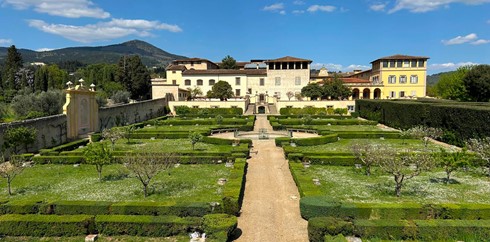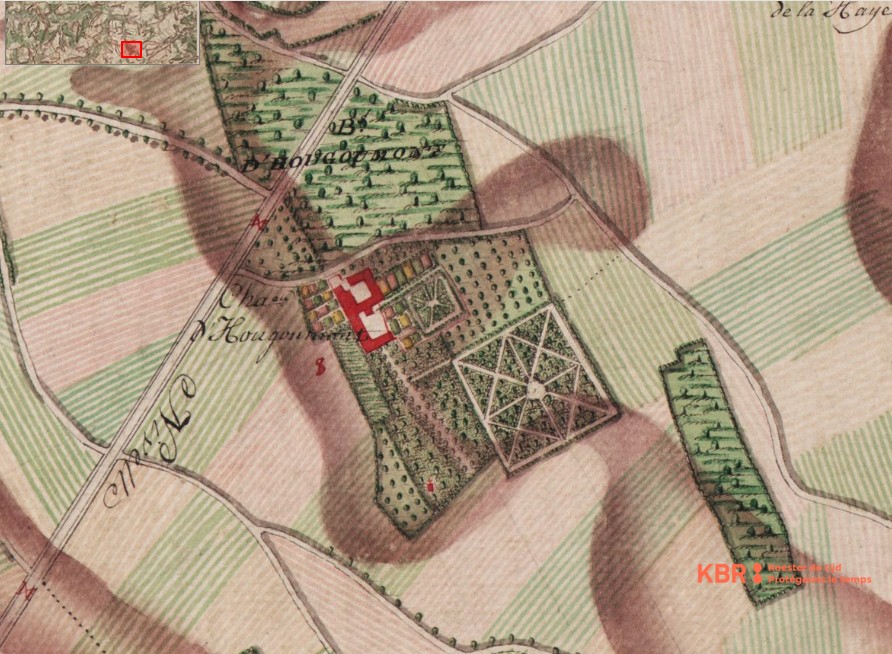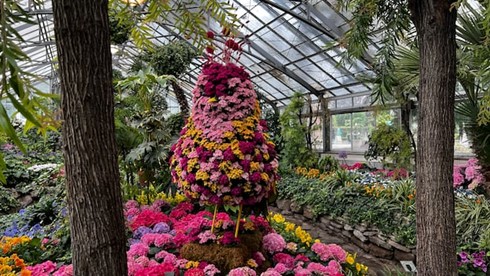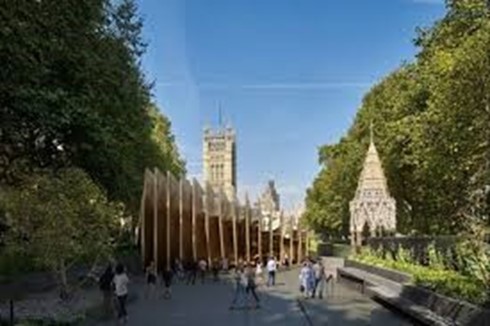In the rural environs of Florence lies the huge Villa La Quiete, a country retreat built by the ruling Medici family. It was the home of the last of the family, Anna Maria Luisa de’ Medici, and also for three centuries a religious foundation for young women of noble family. Between 1724 and 1727, Anna Maria created a simple but beautiful baroque garden for her own pleasure and the recreation of the young ladies, with ten geometric flower beds, two main intersecting pathways, and a central pool. The garden is embellished with fountains, a grotto with cascading water features, and terracotta vases. An adjoining ragnaia (a tree-lined enclosure once used for bird hunting) offers shaded green rooms for relaxation.
After the religious foundation moved out in the 20th century, La Quiete fell into disrepair and it eventually came into the hands of the Region of Tuscany. The Region called in the University of Florence which, with EU financial support, has meticulously restored the garden. The garden has at last been re-opened to the public.
To find out more, click here.
Swords into Ploughshares?On 18 June 1815, the elegant Château of Hougoumont, near Brussels, and its formal gardens found themselves at the key point on the British line facing Napoleon at what became known as the Battle of Waterloo. Though occupied by barely 1000 men, the château resisted ever more desperate assaults by the French and held out to the end of the battle. A notable triumph of British arms but both the château and its grounds were devastated. Not what a landscape architect would recommend for your estate. Over the years, most of the buildings have been restored but the project to restore the gardens was only begun a little over a decade ago. Garden archaeology and the 1777 Ferraris map assisted the process, overseen by François Goffinet, a protégé of Russell Page. The works are being funded from various sources, with the British Government and local heritage groups chipping in. The aim is to restore the large formal parterre and the orchard and add a wild flower garden and rose beds. Goffinet would like to restrict the planting as much as feasible to varieties current in 1815, though he is stuck with a well-intentioned but wholly inappropriate ‘tree of peace’, a gingko grown from the seed of one of the six such trees to survive Hiroshima. Palm Trees in TorontoAllan Gardens Conservatory in Toronto boasts a large complex of five climatically controlled glasshouses, the largest of which is the Palm House with its 12-metre-high, 16-sided central dome giving the building itself the nickname ‘The Dome’. The Palm House was designed by the City architect, Robert McCallum, and opened in 1910. It contains a variety of palm trees and other tropical plants like cycads, gingers, hibiscus and seasonal exotics but, as with all such structures, the internal conditions are not always friendly to glass and metalwork.
By 2022 the Palm House needed a thorough restoration. This programme has included window glazing, glass cladding replacement and modernizing the ventilation and air quality systems and control. In May 2025, the Palm House was triumphantly opened to the public as the centrepiece of the Conservatory’s glasshouses
For further information, click here.
Pessimist (and the bad news)Victoria Gardens – Again!Immediately adjacent to the Houses of Parliament in London there is a small park known as Victoria Gardens, running south along the banks of the Thames. This much-loved space, listed Grade II, contains a number of memorials celebrating anti-slavery campaigners and suffragettes and a copy of Rodin’s The Burghers of Calais. In 2021 planning permission was granted to erect a huge Holocaust Memorial and underground Learning Centre. Given that there are already at least two Holocaust Memorials in London and others elsewhere, the proponents of the Victoria Gardens Memorial have not found it easy to justify the virtual destruction of the Gardens. The Historic Gardens Foundation has spoken out against the project – and ran an article – A New Stonehenge next to Parliament – in Issue 43 of Historic Gardens Review.
The scheme was adversely criticised by UNESCO and is opposed by several Jewish Members of Parliament and organisations. A successful legal challenge was able to halt the development when it was found that building on the site was prohibited by an Act of Parliament of 1900. So keen is the UK Government to display its Holocaust credentials, however, it has even proposed to take up Parliamentary time to pass a new Act to legitimise the scheme.
The latest development is that Europa Nostra, Europe’s foremost heritage organisation, has intervened. Although Europa Nostra is sometimes criticised for not giving enough weight to parks and gardens, on this occasion it has put Victoria Gardens on its ‘7 Most Endangered Programme’, a civil society campaign to save Europe’s heritage in danger. Whether the UK Government is listening, however, remains to be seen. For more information on Europa Nostra's list, click here.
Go lovely rose!When President Trump is working so hard to destroy countries and economies world-wide, perhaps it seems a bit parochial to object to his vandalising a mere garden. Issue 41 of Historic Gardens Review appeared in the autumn of 2000, towards the end of President Trump’s first term. We noted with hesitant approval that (doubtless expecting re-election to be a shoo-in) he had asked the First Lady to restore the famous White House Rose Garden (largely) in accordance with the 1962 plan designed by Rachel ‘Bunny’ Mellon for President and Mrs Kennedy. We were a bit iffy about the replacement of original crab-apple trees by more roses but on the whole – maybe two cheers. That was then. But now we have the re-elected Mr Trump who, as a roaring lion, walketh about, seeking whom he may devour. So, alas, it is no longer roses all the way. The Rose Garden is being paved over to facilitate news conferences and two enormous flagpoles erected. To be fair, the President says that all – or perhaps some - of the work will be paid for by himself. On Monday 9 June, supervised by the President in person, the ground was broken and work began. Readers may not be surprised to learn that the result has been promised to be ‘beautiful’. Gaze on my works, ye mighty, and despair. Do you have any news?
This page is there to share information from all quarters of the World. If you have up-to-date news of a historic park, garden or other designed landscape – gardens recently restored, gardens under threat, even just neglected gardens that need help – do let us know. We can publicise your concerns or help you campaign. Just go to our Contact Us page.
|
|


Hougoumont shown on the Ferraris map of 1777


 |